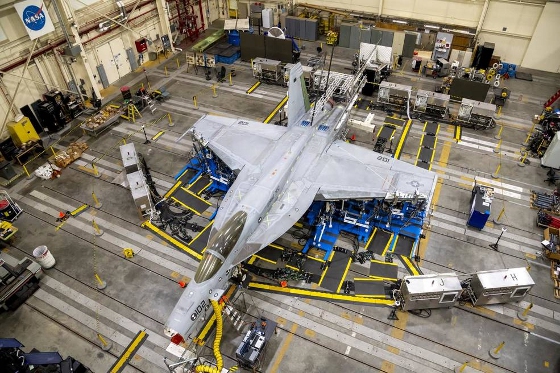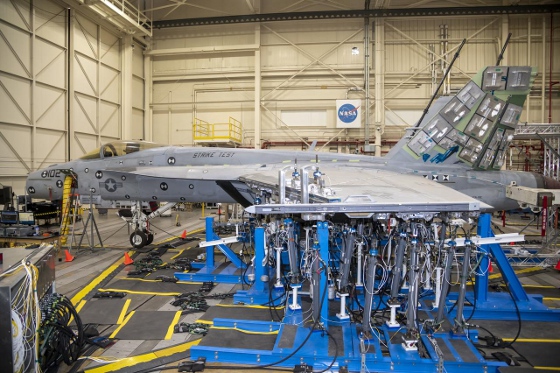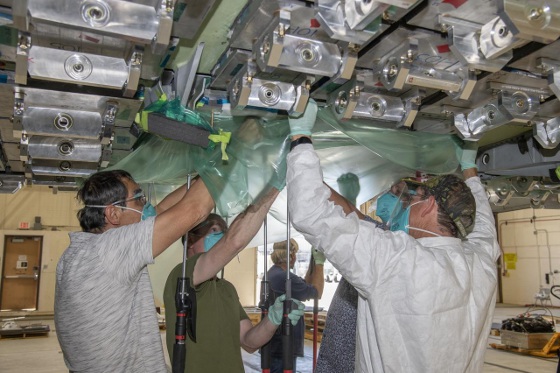 |
| March 01, 2022 | Volume 18 Issue 09 |
Designfax weekly eMagazine
Archives
Partners
Manufacturing Center
Product Spotlight
Modern Applications News
Metalworking Ideas For
Today's Job Shops
Tooling and Production
Strategies for large
metalworking plants
NASA Armstrong assists with complex F/A-18E Super Hornet loads testing
The F/A-18 Hornet is the centerpiece of the US Navy's carrier-based fighter/attack fleet. The F/A-18E/F Super Hornet is a larger version of the F/A-18C/D Hornet. The E/F is roughly 25% larger than the C/D, with a 25% increase in operating radius and a 22% increase in weapons load capability. The single-seat F-18E fighter is the replacement for the F-18C, and the two-seat F/A-18F attack airplane is the replacement for the F-14. The latest iteration is tested and developed under Block III.
By Jay Levine, X-Press Editor, and Elena Johnson, NASA Armstrong Flight Research Center
NASA's Armstrong Flight Research Center's Flight Loads Laboratory in Edwards, CA, is working on its most complex loads calibration tests yet on an F/A-18E Super Hornet.

A top view shows the wing loading test configuration of a F/A-18E from the Naval Air Systems Command (NAVAIR) in Patuxent River, MD. The aircraft is in NASA's Armstrong Flight Research Center Flight Loads Lab in Edwards, CA, for the center's biggest load calibrations tests. This testing is needed before the aircraft can serve as a test vehicle for determining if it can safely manage maneuvers and proposed upgrades. [Credits: NASA/Joshua Fisher]
The aircraft is from the Naval Air Systems Command (NAVAIR) in Patuxent River, MD. NAVAIR retired its previous loads test aircraft, and NASA Armstrong staff are assisting to prepare the new aircraft for its role to help safely manage in-flight maneuvers and determine how the F/A-18E fleet will perform if proposed upgrades are incorporated.
Larry Hudson, NASA Armstrong Flight Load Laboratory chief test engineer, explained a few elements of the work.
"The number of load control channels used at one time is nearly 40% more than the next largest test ever performed in the lab," Hudson said. "Testing involves loading three areas of the aircraft: wings, vertical tails, and horizontal tails. We typically have done loads calibration tests on wings."
Testing on the horizontal tails wrapped up in October 2021. The second phase began in December 2021 on the wings and is set to continue through March. A third phase is estimated to start in May to test the aircraft's two vertical tails.
Testing includes the operation of 84 hydraulic actuators during the performance of 87 load cases, said Kim Tucker, NASA Armstrong F/A-18E test project manager.
That includes the simultaneous operation of 56 actuators during the loading tests on the wings to determine the structure's response.
"For each test case, hydraulic actuators will push and/or pull on the aircraft surface to put it into tension or compression with a known amount of force," Tucker said. "Strain gages installed on the aircraft will measure the response."
The amount of load applied to the aircraft starts low and then increases with subsequent test cases.
"The load cases for this test were designed to reach a maximum of approximately 60% of the airframe allowable limit load," she explained. "There are 11 horizontal tail load cases, 62 wing load cases, and 14 vertical tail load cases, resulting in a total of 87 test cases."

Left wing load hardware is set up for testing a F/A-18E. The aircraft is in NASA's Armstrong Flight Research Center Flight Loads Laboratory in Edwards, CA. [Credits: NASA/Joshua Fisher]
As each phase is completed, equations are formulated from the test results.
"Equations are used to evaluate real-time loads during test flights and simulations," she explained. "Those real-time loads consist of aerodynamic and inertia loads, or forces that the aircraft structure experiences during flight."
The laboratory is not unfamiliar with load calibration programs and brings that experience to this work. For example, there was an important lesson learned from the F/A-18 Active Aeroelastic Wing Loads Calibration Test in 2001 that involved reduction in the test load limit.
"The biggest lesson learned was the fact that you do not have to load test an aircraft wing beyond 60% of the design limit load to obtain accurate loads equations," Hudson explained. "Being able to test to a lower load limit reduces the risk of damaging the aircraft during testing."
One of the biggest challenges early on for this project was bonding the 180 load pads to the wings and vertical tails. It provided an opportunity for NASA Armstrong staff to innovate, as they frequently do during a project.
"We had to develop a well-thought-out vacuum bonding process for both horizontal and vertical surfaces, which required doing it right the first time," he added.

From left, Ronnie Haraguchi, Chris Mount, and Ray Sadler vacuum bag load pads on the aircraft surface of an F/A-18E. [Credits: NASA/Lauren Hughes]
NAVAIR's F/A-18E arrived at NASA Armstrong in October 2020. The aircraft was configured for test by removing parts not needed for the calibration and installing test-specific hardware where necessary, Tucker said.
Aircraft wing- and tail-pad bonding surfaces were prepared by removing the radar-absorbent material and paint coatings and applying a fresh layer of primer to promote load-pad adhesion.
NASA Armstrong completed setup of all the load pads and bonding and assembled test structures called whiffle trees needed to distribute prescribed hydraulic actuator loads. Before the F/A-18E was brought into the laboratory and attached to the floor tracks with restraining hardware, center staff also worked on load-pad bonding onto the aircraft.
In addition, work was completed on the design, analysis, and fabrication of many hardware pieces for the test setup. The hardware pieces included fixtures for the wing test, horizontal spindle test, and vertical tail test, as well as aircraft restraining hardware, and hundreds of components for the load trains, or the columns of hardware through which load travels, and whiffle trees.
The overall effort is expected to be complete by summer 2022, when test-specific hardware will be removed and the aircraft will be configured for flight and returned to NAVAIR. When it returns, the work NASA Armstrong staff assisted with will enhance safety for the F/A-18E fleet by understanding the implications of proposed upgrades and in-flight maneuvers.
---------------------
According to the U.S. Navy, "The latest Block III upgrade, currently undergoing test and evaluation, extends the platform's service life and range, and incorporates an advanced cockpit system, reduced radar cross-section, and an advanced networking infrastructure. The Boeing Company delivered two F/A-18 Block III Super Hornet test jets to the U.S. Navy in June 2020, with production to follow successful testing and a contract in place to provide 78 new-build F/A-18 Block III jets to the Service through 2024."
While substantially larger than its predecessor, the F/A-18 Hornet, at roughly 7,000 lb heavier and with a 50% higher range, the Super Hornet was delivered with fewer parts and lower maintenance demands.
Bonus factoid: The U.S. Navy's Blue Angels Flight Demonstration Squadron transitioned to the F/A-18 Super Hornet in 2021.
Published March 2022
Rate this article
View our terms of use and privacy policy
